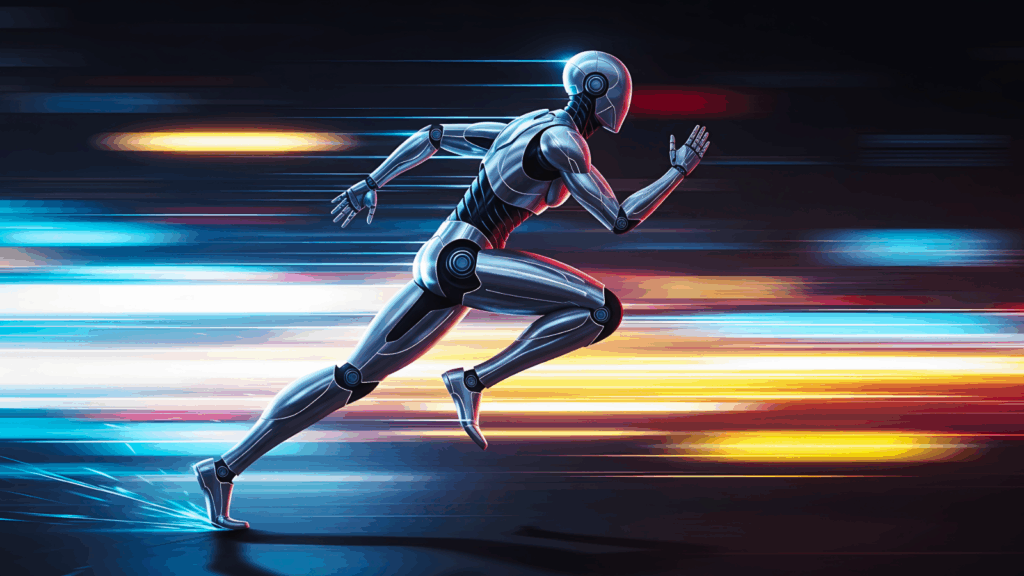Humanoid Robots Are Awkward Now – But Not for Long
Just days ago, Beijing’s National Speed Skating Oval – the same gleaming arena that once hosted Olympic champions – was home to a very different kind of athlete.
There were no human sprinters, seasoned boxers, or martial arts prodigies.
Instead, hundreds of humanoid robots competed in track and field events, squared off in boxing rings, even stumbled their way through dance battles in the inaugural World Humanoid Robot Games.
The event featured more than 500 bots from 16 countries, which competed in 26 events ranging from sprints to more practical acts, like performing hotel concierge duties. Some wowed crowds with their abilities, like China’s own Unitree Robotics, whose “H1” humanoid stole headlines by winning gold in multiple track events. Others collapsed mid-stride, forming robot pileups that drew both laughter and applause.
But the mere fact that hundreds of humanoids were competing at all – running, fighting, balancing, carrying – was the real victory. Indeed, as NBC noted: “the games were less about winning or losing and more about testing…agility, endurance and battery life, all of which have made great advances in recent years.”
This wasn’t a robotics trade show tucked away in a local convention center. It was a global sports event broadcasted to the world, where humanoid robots demonstrated tangible progress, flaws and all.
And just like the Wright brothers’ rickety first flights, the stumbles are less important than the takeoff itself…
Humanoid Robots Step Into Daily Life
For years, humanoid robots were the butt of late-night TV jokes. Plenty of folks poked fun at Honda’s ASIMO shuffling across a stage or Boston Dynamics’ Atlas attempting parkour.
But in 2025, the narrative has flipped. These machines aren’t confined to research labs anymore. They’re now stepping into jobs, homes, and even geopolitics.
Take Tesla’s (TSLA) Optimus. Once dismissed as an over-hyped Elon Musk sideshow, Optimus is now serving food at the Tesla Diner in Los Angeles. Guests snap photos of the robot scooping popcorn, and Musk says Optimus will soon be a food runner, delivering burgers and shakes within a few months. It’s part marketing stunt, part proof-of-concept. But it sends a clear signal: humanoid robots are crossing into consumer culture.
Then there’s President Trump’s Mar-a-Lago estate, which has reportedly deployed robotic guard dogs as part of its security perimeter. These aren’t humanoids, of course. But the symbolism is striking: a U.S. president trusting autonomous robots with real-world defense. It’s a sign of how far embodied AI has penetrated the national psyche.
Corporate America is moving faster still. Walmart (WMT), the country’s largest employer, has quietly automated nearly all of its warehouses with fleets of robots that handle restocking, packaging, and logistics. Amazon (AMZN), global e-commerce giant, now boasts over 1 million robots across its fulfillment network – everything from squat wheeled bots that shuttle bins to early humanoids designed for handling irregular packages.
And it doesn’t stop there. Foxconn (FXCOF) is experimenting with humanoid robots on its factory floors in China. Hyundai’s Boston Dynamics is piloting humanoid units in logistics and construction tasks. Even hospital systems in Japan and South Korea are trialing these bots as medical aides, capable of lifting patients, fetching supplies, or just keeping lonely seniors company.
What was once a speculative dream – the C-3POs and Rosie the Robots of our childhood imaginations – is finally becoming a tangible reality.
Why Humanoid Robots Are Finally Ready for Prime Time
The leap from clumsy prototypes to real-world deployment is no accident. Three converging forces explain why humanoids are suddenly everywhere:
Together, these factors have pushed humanoids past the “impressive demo” stage into commercial inevitability.
History tells us that technological inflection points – like the one we’re seeing right now as humanoid robots move from concept to reality – are messy but lucrative.
Early cars overheated and broke down all the time. Early airplanes crashed so often newspapers called flying a “suicidal pastime.” And before 2007, mobile devices were clunky tools for business professionals – until the iPhone made them indispensable.
Now robots are approaching the same launch pad.
The Multi-Trillion-Dollar Robotics Market
The World Humanoid Robot Games captured this moment perfectly – awkward and awe-inspiring at once.
For investors, the lesson is clear: don’t focus on today’s stumbles but on the fact that the race has already begun.
Tesla, Amazon, Walmart, Unitree, and others aren’t building humanoids for YouTube likes. They’re solving trillion-dollar problems in logistics, security, manufacturing, and elder care. That’s why China has pledged more than $20 billion in subsidies, and why the U.S. is fast-tracking robotics under its AI and industrial policies.
Consider the potential markets:
- Logistics & Warehousing: According to the Bureau of Labor Statistics, “In June 2024, the [U.S.] transportation and warehousing industry had an employment level of 6.6 million, accounting for 5 percent of all private-sector jobs.” Even partial replacement could unlock a multi-billion-dollar opportunity.
- Healthcare & Elder Care: The healthcare humanoid robot segment was $2 billion in 2023 and is expected to grow at 16.9% CAGR through 2032. The broader eldercare assistive robotics market is expected to climb from $3.17 billion in 2025 to $10.23 billion by 2035, making humanoid caregiving a fast-expanding field.
- Hospitality & Retail: The wider customer-service humanoid robotics market could surge from $0.465 billion in 2024 to nearly $15.8 billion by 2034, fueling use cases from robot diners to automated check-ins.
- Defense & Security: The global security robot industry was $16.5 billion in 2023 and is projected to climb to around $44- to $57 billion by 2030. The military robots component alone is expected to grow from $19.7 billion in 2024 to $32.5 billion by 2030.
- Domestic Assistance: The household robot market is estimated to hit $95 billion by 2033. Oxford researchers predict up to 40% of chores will be automated within a decade, pointing to mass-market appeal for home-helper bots once cost and reliability improve.
This once-distant sci-fi scenario is unfolding right now, accelerated by the same AI revolution powering ChatGPT, autonomous vehicles, and generative video.
Be the investor who treats today’s humanoids like the 2007 iPhone: awkward at launch, vital a decade later.
The Future Belongs to Embodied AI
The 2025 World Humanoid Robot Games were a declaration, not a spectacle.
Humanoid robots are no longer science fiction. They are here and improving fast.
From Tesla’s Optimus to Amazon’s million-strong robotic fleet; Walmart’s automated warehouses to Trump’s robotic guard dogs, embodied AI is crossing into daily life.
For investors, this is the moment to act; not because robots are flawless today, but because the trajectory is unmistakable. Back the winners early, and you’ll own a piece of the next trillion-dollar industry.
Right now, behind the scenes, an ecosystem of suppliers is gearing up to power this robotic future: companies producing the sensors, edge chips, power modules, actuators, and embedded inference engines that turn AI code into real-world capability.
If you want to get your portfolio ready for the next leap in this megatrend, don’t get distracted by the flashy AI applications or speculative meme plays. Zero in on the components – and the companies – making them possible.
The post Humanoid Robots Are Awkward Now – But Not for Long appeared first on InvestorPlace.






